#artist's book
Text

Excursion to philisophy , Hopper's house - Ángel Mateo Charris , 1996.
Spanish, b.1962 -
Oil on canvas, 195 x 130 cm.
#Ángel Mateo Charris#spanish artist#coastal landscape#Cape Cod#Footprints of Hopper#art writing#artist's book
253 notes
·
View notes
Photo

Tiane Doan na Champassak — CENSORED (Special edition)
162 notes
·
View notes
Text




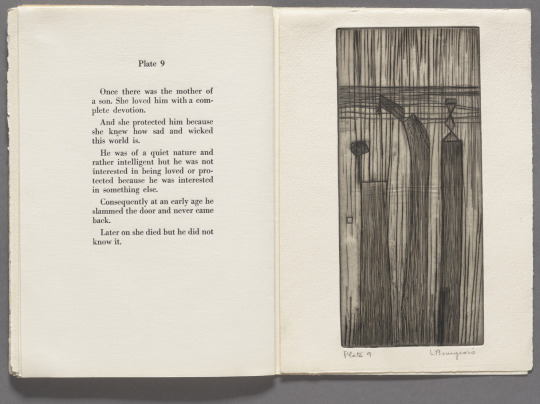
He Disappeared into Complete Silence - Louise Bourgeois
8 notes
·
View notes
Photo

Robert Moran created Sketch for a Tragic One-Act Opera specifically for John Cage’s Notations book project. Its nontraditional score includes a razor blade taped to the page.
41 notes
·
View notes
Text

Pregnancy diary by Chana de Moura
9 notes
·
View notes
Photo

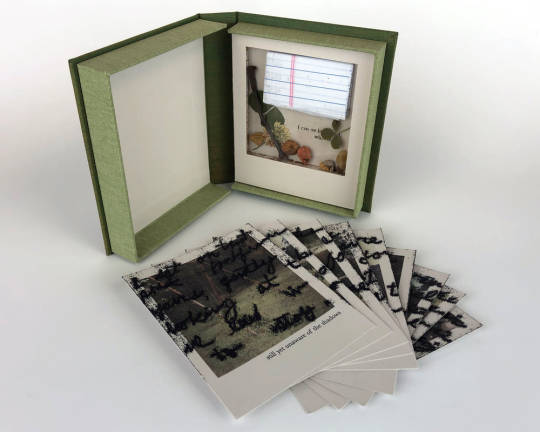
Memento, 2015-2022
Beth Sheehan
Nine panels and a time-capsule housed in a clamshell box. Prints: Inkjet printing, letterpress printing and trace monotypes. Time-capsule: Inkjet printing, sand from childhood home, pebbles, clovers, eyelash.4 inches x 5 inches x 1 inch (closed).9 pages. Edition of 18.
Due to my lack of episodic memory, I have become obsessed with the documentation of my past. The photographs in this piece are inkjet prints of Polaroids that I took while visiting my childhood home in 2014. While home, I also documented my childhood journals. The trace-monotype text on these nine panels is from an excerpt of one of my entries. The act of re-writing the entry through trace monotype on each panel for the edition afforded me a kind of catharsis. Through the repetition, my aim was to solidify the memory of that day in my mind forever.
The letterpress printed text was derived from my attempt to recall the events of the journal entry a year after repeatedly re-writing it. So much of the entry has disappeared from my memory, leaving me with only hints and feelings of the day long past.
Finally, the clamshell box and time-capsule were created 7 years after the original prints were made. Science suggests that the cells in our bodies replace themselves every 7 years. This fact is particularly interesting to me when contemplating how memories are likely stored and transferred to new cells during this regeneration process. By housing the remnants of the memory in the new clamshell box, the memories remain protected and are given a new context.
#beth sheehan#sheeprints#book arts#artist book#artists book#artist's book#book art#clamshell box#art
6 notes
·
View notes
Photo



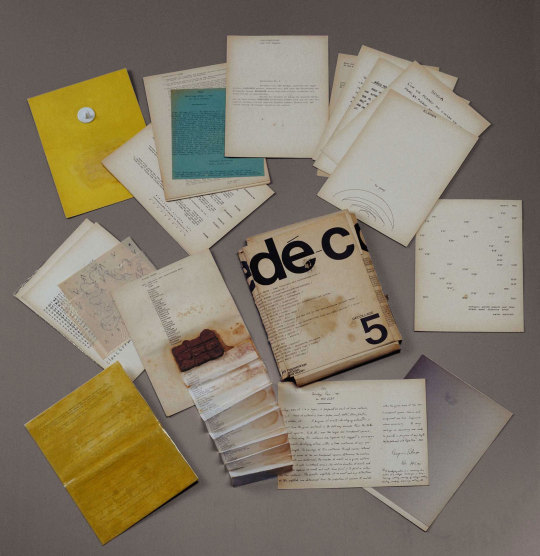
Wolf Vostell (DE, 1932 - 1998)
_
WOLF VOSTELL 2 dé-coll/age-happenings BERLIN 1965. Artist's book: screenprints on laminated paperboard with metal hand-screw clamp. Page: 21.5 × 10.7 cm. Publisher: René Block - Printer: Hochacker, Wuppertal
The Gilbert and Lila Silverman Fluxus Collection Gift
FONDAZIONE BONOTTO - Vostell, Wolf - Dé-Coll/age Happenings
Wolf Vostell | Dè-Coll/Age (1966) | Artsy
https://www.moma.org/collection/works/172870?artist_id=6191&page=1&sov_referrer=artist
https://collections.geneve.ch/mah/oeuvre/2-de-collage-happenings-edition-1-rene-block-galerie-berlin/gevbaaa20023566
#Wolf Vostell#artist's book#book binding#minimal#brut#design#modernism#paper#assemblage#box#collage#visual communication
9 notes
·
View notes
Photo

Page 128 from The Body Problem. Paperback and hardcover versions of the entire sequence are available here.
#the body problem#c r e wells#letitia trent#faint press#visual poetry#vispo#poetry#asemic writing#collage#digital collage#artist's book
8 notes
·
View notes
Photo
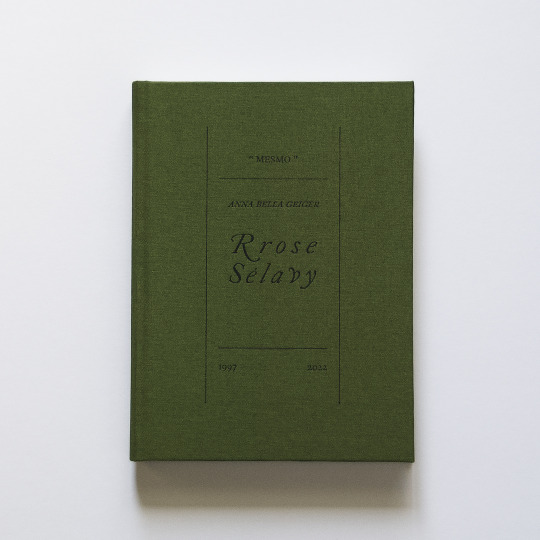

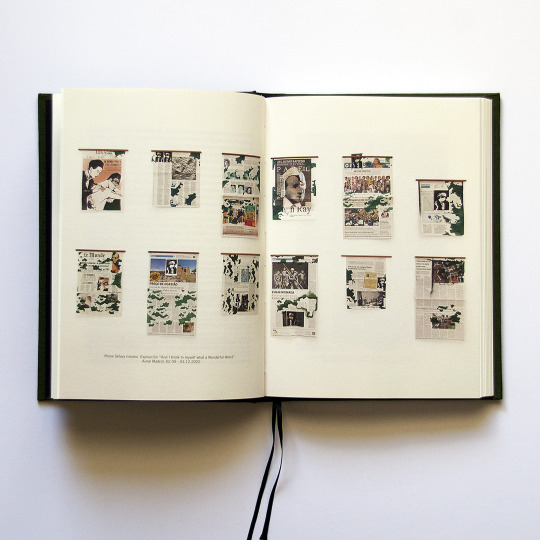

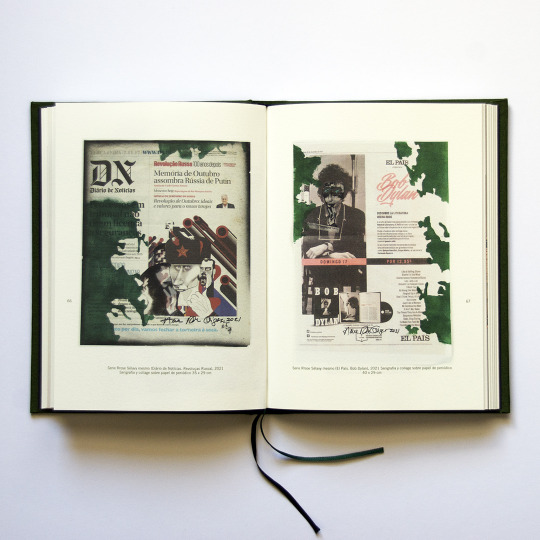





Concepto y diseño del libro para la artista brasileña Anna Bella Geiger.
“Rrose Sélavy mesmo” es el título que corresponde a la la serie de obras que Anna Bella viene realizando desde 1997 hasta hoy.
El libro tiene un texto inicial donde la artista, a modo de carta dirigida a Marcel Duchamp, describe cómo se originó la serie, hace hincapié en la importancia de los procesos artísticos a la hora del hallazgo, así como su planteamiento en la selección de periódicos para sus intervenciones en ellos utilizando la imagen de Rrose Sélavy que Man Ray le hizo a Marcel Duchamp. Los periódicos elegidos son varios aunque predominan Folha da Tarde, Globo, Le Monde, El País, Frankfurter Allgemeine o New York Times.
Anna Bella Geiger es una de las artistas brasileñas más valoradas en la escena internacional, considerada una de las pioneras en el uso de medios no convencionales para experimentar otras formas de plantear y cuestionar el presente. Su obra está presente en todo el mundo en las colecciones del Museo de Arte Moderno, Nueva York; Centro Pompidou de Paris, Fogg Museo, Cambridge; Getty Fundación, Los Ángeles; Museu Serralves, Porto; Frankfurter Kunstverein, Fráncfort; Museo Nacional Centro de Arte Reina Sofía, Museo de Arte Contemporáneo, Chicago entre otros.
Cliente: Aural Galería
#arte#arte contemporáneo#art#contemporary art#artist#artist's book#book#book design#galerias de arte#anna bella geiger#brasil#libros de arte#art books#rrose selavy#marcel duchamp#art advisor#galeria aural
2 notes
·
View notes
Photo

You may now order the paperback version of The Body Problem here:
https://www.lulu.com/en/us/shop/cre-wells-and-letitia-trent/the-body-problem/paperback/product-k2eqqy.html?page=1&pageSize=4
"Wells and Trent wander through ruins of a medical dictionary, digitalia, and collage to create a severe pose as commentary on destruction and decay of the body--and the body as phenomena. Wells, in his introduction, says 'with art comes form, and with form come limits.' And is not the body limited by the only human surety: death? But, ultimately it is all about creation. I applaud the aesthetic of this collection of riveting images. Another required text for Asemia and Visual Poetry."
--Kristine Snodgrass, author of RANK
"A brilliant exercise in both repetition and symmetry... Wells applies Trent’s words to the page over and over in ways that remind the reader/viewer of the different effects that happen in a hall of mirrors. There is always another place to turn and look again from a new perspective."
--Amanda Laughtland, publisher of Teeny Tiny Press
#visual poetry#vispo#poetry#spilled ink#collage#digital collage#digital art#asemic#asemic writing#asemicwriting#Letitia Trent#c r e wells#chris wells#chris r e wells#collaboration#artists on tumblr#poets on tumblr#artists books#artist's book#art#arte#kunst#contemporary art#contemporaryart#contemporary#faint press
8 notes
·
View notes
Photo



[ID: First image is eleven half-spheres, painted to look like the sun, moon, eight planets, and Pluto against a black background. The second two images are the flat sides of two of the hemispheres, the sun and Mercury, which have writing that spirals into their associated alchemical signs in the center.
Writing for the sun: We glow. The light in our eyes and hearts is undiminishable. It burns hot and bright, and will continue to do so for longer than life. We shine, a radiance reflected off of those nearby, and we learn how to warm ourselves and others. A churning sea of hot plasma and tangled magnetic field lines fling flares and hope far out into the emptiness. Unimaginable pressure is turned into something to guide, to inspire, to illuminate. We have found a way to turn the living consumption of ourselves into light and life. Against the darkness, we glow.
For Mercury: We remember. With no wind and water, nothing slowly erodes cracks and craters. A record of the past is found in gray dust skin, millions of years of impacts and fractures tattooed across the surface. What is it like, to know your past completely and wholly? To have every hurt, every moment embedded so strongly that it cannot be erased? We face fresh collisions in the empty cavities of ones carved ages ago. We learn and understand, new experiences mingling with old until everything is a blur of hollow and ridge. With every bit of us, we remember.]
Going back through old art I never got around to putting up here and discovered this artist’s book called “atlas” I made for a class years ago - it’s a pity you can’t touch things through the internet, but I can confirm they’re nice to hold!
(rest of the objects under the cut)
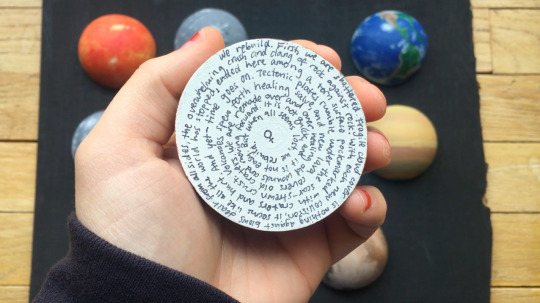
Venus: We rebuild. First, we are shattered. Fragile cloud cover is nothing against blows dealt from all sides, the overwhelming crush and clang of rock against rock. With each new collision, it seems like all the world has stopped, ended here among a torn surface pockmarked with craters and hurt. And yet - time goes on. Tectonic plates rumble under the scar-strewn crust. Volcanoes spew forth healing salve, and new lava covers old craters We are remade over and over, healing old wounds and moving forward. It is not quick, and it is not easy. But when all seems lost, we rebuild.

Earth: We shelter. In this first and only home we’ve ever known, we find safety. We are raised by others around us, planted in soil made of the tiniest bits of this place. It is easy to forget what that means, and how that feels - to be connected, alone in the universe. It is easy to forget the traces we leave behind in litter, in footsteps, in stones, in each other. We’ve built skyscrapers and lives grounded in the dirt beneath our feet, roots tunneling so deep in this chunk of rock that somehow, we feel safe, home. Above everything, we shelter.
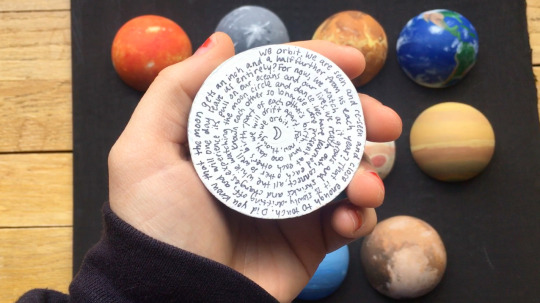
Moon: We orbit. We are seen and re-seen and close enough to touch. Did you know that the moon gets an inch and a half further from us each year? That it is slowly drifting off, and will one day leave us entirely? For now, we watch as it grows and shrinks and changes, experience its pull on our oceans and our lives. We reach out, connect, all the while watching the moon circle and dance. We have learned each other so well, known each other so long. We were present at each other’s birth - part of each other’s birth. And one day, we will drift apart. For now, though, we orbit.

Mars: We grow. Life arises in the most unexpected of places - through the cracks in concrete, in pitch-dark caves, at the bottoms of oceans. What determines where it grows? Is there a special formula - a handful of hope, a pinch of freedom, a bit of love, and a spark, to set it all going? Life exists everywhere, both where we have found it and where we have yet to discover it - something so rare and yet something so common, that perseveres through conditions we never thought possible. Life, in some form, goes on and on, and we will always find it. Even through hardship, we grow.

Jupiter: We triumph. What do we know of greatness? How do we define it, determine it, measure ourselves up against it? Success is often quantified by magnitude - by the number of people reached, by how far a message spreads, by how large a profit is earned. Is that the right way to see it? We are constantly achieving little victories. We change lives in the tiniest of ways, and looking to the largest of accomplishments only blinds us to quieter greatness. It is not necessary to become significant - only to do significant acts. When we try at all, we triumph.
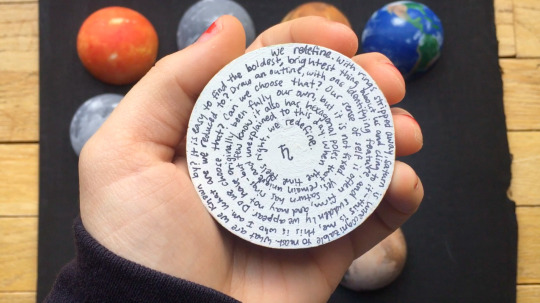
Saturn: We redefine. With rings stripped away, Saturn is unrecognizable to most. What are we known by? It is easy to find the boldest, brightest thing about us and cling to it - this is me, this is who I am. What are we reduced to? Draw an outline, with one identifying feature, and suddenly we appear. Do we choose that? Can we choose that? Our sense of self is often firm, and may not have originally been fully our own, but it is not fixed. Yes, Saturn has rings - but few know it also has hexagonal poles that remain unique and unexplained to this day. When the time feels right, we redefine.
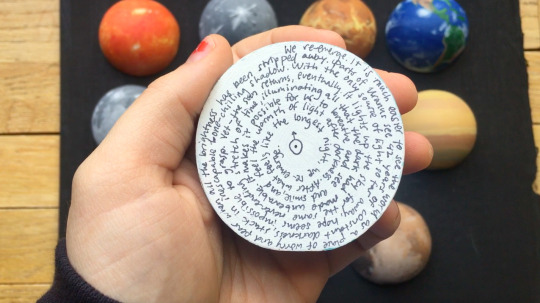
Uranus: We re-emerge. It is much easier to see the world as a place of worry and fear when all the brightness has been stripped away. Parts of Uranus see 42 years of constant darkness, stuck in inescapable bone-chilling shadow. With the only source of light so far away, hope seems impossible to grasp. Yet - the sun returns, eventually. It lights up the sky for the same never-ending stretch of time, illuminating all that the dark has made unbearable. It makes it possible for us to breathe and see and smile, and feel the warmth of light after darkness. After what feels like the longest night, we re-emerge.

Neptune: We connect. Distance may be an obstacle, but it is possible to feel the warmth of a distant sun, to be content with a close moment once every century and a half. It certainly isn’t effortless, but it is possible. Separation hurts and excludes and prevents but it is more an emotion than a physical reality. We make do with what we can. We send probes, pictures, anything that can cross the billions of miles between us. We learn about each other and search for something to make us feel close. Despite the distance, we connect.

Pluto: We belong. It is hard to recognize exactly where our place is. We push ourselves to find it, to fit in, to follow as quickly as possible. When most of the criteria is met, we check off the box and label ourselves, hoping the rough fit around the edges goes unnoticed. It is simple to find that box and stay there, crushed up against the cardboard walls, even if something about it doesn’t feel quite right. Instead, we must push ourselves to find a new space, a new label, one to fully claim and fully feel and fully enjoy. When we finally find it, we belong.
#there's two other comics I've got that i'll put up shortly too#space#planets#sun#moon#astronomy#solar system#artist's book#my art
4 notes
·
View notes
Text
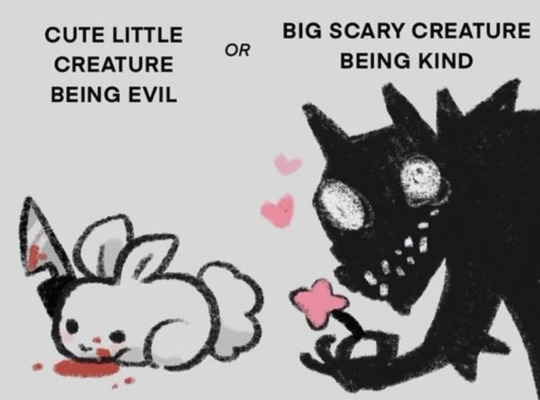
#funny#lol#haha#humor#meme#memes#dank memes#dark academia#light academia#chaos academia#art#draw#drawing#artists on tumblr#grunge#soft grunge#goth#gothic#witchcore#witchblr#witch#dark humor#animals#bunny#bunnies#pale#alternative#words#quotes#books
116K notes
·
View notes
Text

Leigh Ledare | Double Bind, 2012
Artist's Book in 3 volumes. Volume I: 96 pages; Volume II: 112 pages; Volume III: 6 journals each containing 80 pages
Volume I: 27.9 x 21.6 cm (11 x 8.5 in); Volume II: 38.3 x 30 cm (15 x 11.8 in); Volume III: 41.3 x 30.9 cm (16.2 x 12.1 in) each
Edition of 85 + 15 AP
19 notes
·
View notes
Text

#art#draw#drawing#words#quotes#books#book quotes#flowers#flowercore#naturecore#cottagecore#aesthetic#artists on tumblr
66K notes
·
View notes
Text


What books have you done this to?
Instagram / Shop
64K notes
·
View notes
Text

Notebook. By Chana de Moura
2 notes
·
View notes